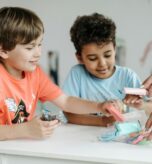Education today goes beyond academics. There is a growing global recognition that schools must also nurture students’ social and emotional development, helping them build empathy, resilience, self-awareness, and interpersonal skills. But are schools truly prepared for this vital role?
To answer this question, the OECD conducted a major study in 2019 across nine cities worldwide (including Istanbul), examining how well schools support the development of social and emotional skills (SES) in 10- and 15-year-old students. The findings, published in 2023, provide a detailed examination of the current state of social and emotional learning (SEL) in schools and identify areas that still require improvement.
Why This Study Matters?
The Survey on Social and Emotional Skills (SSES) collected insights from students, teachers, and principals to understand how SEL is approached in schools.
Participating cities included: Istanbul (Türkiye), Helsinki (Finland), Houston (USA), Suzhou (China), Bogotá and Manizales (Colombia), Ottawa (Canada), Daegu (South Korea), and Sintra (Portugal).
The report emphasizes that SES is essential for academic success, long-term employment, health, and life satisfaction. Yet, it also highlights that many school systems lack the structured policies, resources, and teacher training needed to support SEL effectively.
Do Schools See Social and Emotional Skills as a Core Goal?
Encouragingly, over 90% of school leaders said that developing social and emotional skills is a core objective, on par with academic achievement. But while the intention is there, actual implementation is uneven.
Curriculum vs. Reality:
Many countries include SES in their official education frameworks.
However, there’s often a disconnect between policy and classroom practice.
The success of SEL initiatives depends heavily on how school staff interpret and apply these policies.
How Are SES Assessed in Schools?
Assessment is crucial for tracking progress. While academic skills are routinely evaluated, social and emotional skills are not.
About 75% of 10-year-olds attend schools where SES is assessed.
This drops to 66% for 15-year-olds.
Assessments are often informal (e.g., teacher observations) and rarely standardized.
Most assessment data is shared only with parents, not school administrators or policymakers.
Who gets access to the data?
90% of 10-year-olds’ SES results are shared with parents.
For 15-year-olds, it’s 84%.
Only around half of teachers report SES insights to school leaders.
Just 40% share these findings with education authorities.
This limits the broader use of SES data to inform school-wide or system-level improvements.
How Do Schools Promote SEL?
Most schools support SEL through embedded practices—integrating it into daily routines rather than offering standalone programs.
Common strategies include:
Classroom management and discipline
Teacher responsibilities
Communication with parents
Including SES goals in school plans
While valuable, these approaches risk treating SEL as a by-product of academic learning. When schedules are tight, SEL activities are often the first to be dropped.
Direct approaches are less common:
Fewer than 60% of 15-year-olds are exposed to dedicated SEL programs or lessons.
Extracurricular activities, though proven effective, decline sharply with age.
This gap may explain why older students show lower SES levels in areas such as optimism, sociability, and trust.
Are Teachers Prepared for SEL?
One of the report’s most significant findings is the lack of adequate teacher training in SEL—especially for those teaching older students.
Age-based differences:
Teachers of 10-year-olds are more likely to have received training in child development, group learning methods, and emotional skill-building.
Teachers of 15-year-olds report significantly less preparation in these areas.
For example:
25% of younger students had teachers who received in-depth training in SEL.
Only 16% of older students did.
Why training matters:
Teachers with stronger training report:
Higher confidence (self-efficacy)
More use of active learning techniques
Better relationships with students
This suggests that well-trained teachers help create more supportive learning environments.
The Missing Link: Parental Involvement
Parents are essential partners in social and emotional development. Yet, schools involve them less as students grow older.
90% of 10-year-olds’ teachers report regularly communicating with parents about SEL.
This drops to 84% for 15-year-olds.
This decline happens at a time—adolescence—when students arguably need emotional guidance the most.
OECD’s Recommendations: What Should Change?
To transform schools into genuine centers of SEL, OECD proposes five key actions:
•Integrate SEL into assessment systems
SES should be evaluated regularly, not just observed casually.
•Use SEL data system-wide
Share findings with principals and policymakers, not just parents.
•Allocate dedicated time and resources
Don’t rely only on integration; offer direct SEL activities and programs.
•Involve parents at all levels
Maintain collaboration with families throughout primary and secondary education.
•Invest in sustained teacher development
Short workshops aren’t enough. Teachers need ongoing, practical training to effectively support SEL.
Conclusion: Rethinking What Education Means
The OECD’s study reminds us that schools do more than deliver facts—they shape people. Social and emotional learning is not an optional extra; it’s a fundamental component of 21st-century education.
By equipping students with the emotional tools to navigate life, schools can help create not only successful learners but also empathetic citizens, capable collaborators, and resilient individuals. The path forward is clear: integrate, prioritize, and support social and emotional learning at every level of the system.
Sources:
OECD (2023), “Schools as hubs for social and emotional learning: Are schools and teachers ready?”, OECD Education Spotlights, No. 4
OECD (2023), “Survey on Social and Emotional Skills (SSES)” overview
OECD (2024), “Social and Emotional Skills for Better Lives”
OECD commentary highlighting dip in 15‑year‑olds’ skills




